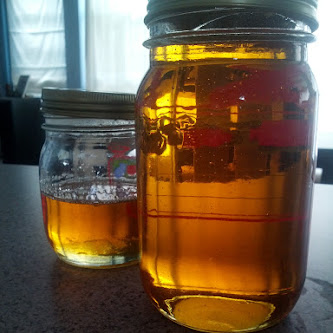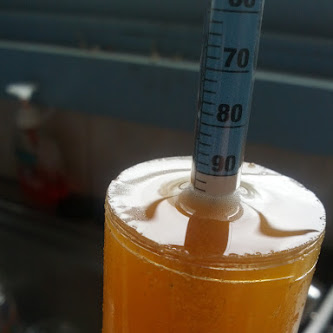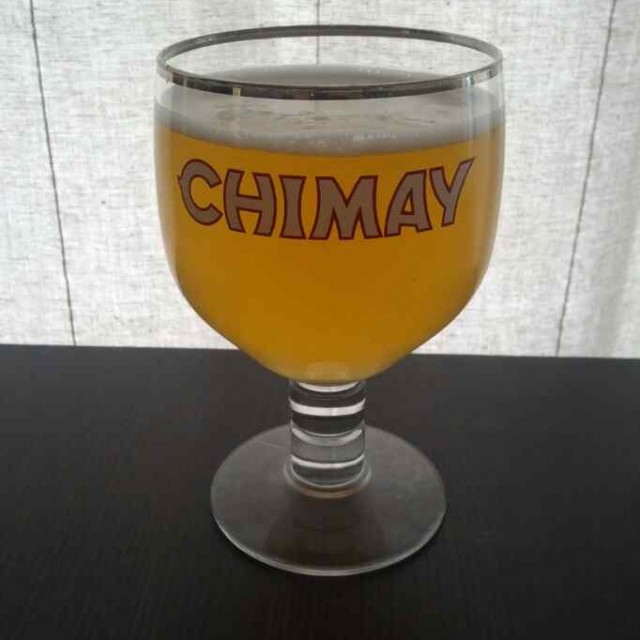codswallop
Member
I was referring to a diacetyl "infection" as opposed to a regular style of infection. Haven't had any infection, luckily.In my experience an infected brew is pretty strong.
I was referring to a diacetyl "infection" as opposed to a regular style of infection. Haven't had any infection, luckily.In my experience an infected brew is pretty strong.
Brewing Sierra Nevada Pale Ale clone today, what's everyone else brewing this week?
Got a new immersion chiller, home made fly sparge arm (it's the sparge method I learnt so have stuck with it even if its harder than other methods), and a couple of other process tweaks for today.
It's still below freezing on the deck, so could be a cold brew day. I have to brew outside to avoid stinking the house out - hops make my wife sick...
Got my water heating up to strike temperature right now for a quick brew - simple brew of 2-row, dash of 120L & some carawheatI always brew outside, it's just easier to manage & my wife hated the malty grain smell from my first brew experiment. I brew outside on the patio or by front of the house. As a software guy, it's nice to be outside "making" something crafty by myself mostly.
And that's it in the fermenter. Phew, what a brewday. Ran out of propane. Scorched my wort while trying to get it back upto boiling. But hit my OG (~1.072). We shall see how it turns out.
12lb 10oz 2 Row
1lb Crystal 150L
1/2lb Caramel Wheel
2oz Polaris - 60m
1oz Falconers Flight - 15m
1oz Falconers Flight - 5m
2 packs Safale 05.
Yeastie Boys (a New Zealand brewer) released the recipe for their Digital IPA a while back:The Sierra Nevada Pale Ale recipe I used - apparently from the head brewer according to the northern brewer forums (5gal into fermenter)
Yeastie Boys (a New Zealand brewer) released the recipe for their Digital IPA a while back:
http://yeastieboys.posterous.com/private/yCmgJxeHrs
Are there any other brewers officially (or unofficially) giving the homebrew community their recipes? Is there a repository of them, I wonder?
I've found many brewers are pretty excited to talk about what they do with homebrewers (had a chat with one in a bar on Friday, actually). More and more nowadays are becoming pro brewers after being homebrewers for a long period of time too, so sharing recipes is already second nature to them.Stone has a book out with various recipes in it. Ask!
You'll be fine. The yeast does most of its work in the first 48 hours. Bringing it back up to a regular temperature will kick it back into action if it needs to & do any finishing it can. Relax, drink a homebrew
Not necessarily. Movement, temperature changes, and CO2 being exhausted can all do it. Airlocks are an OK indicator, but not the only indicator.Does this airlock activity mean fermentation has continued?
This is the right answer. Take a reading, and drink it while you're there. Why not? It's worth knowing how "young" beer tastes (it usually gets better with age, so don't let a "green" or "young" flavour put you off).I know that taking the gravity is the real way to answer the question, and I'm certainly going to take the gravity before I bottle.
A high temperature will definitely do it. When did you take the reading exactly? I once let my wort cool and settle, and when I took the reading (only a scoop from the top) it was way off. I didn't realise it until too late. Make sure the wort sampled is cool and representative of the consistency of the whole batch.Because of the temperature confusion I mentioned in my original post, I think I took the original reading at too high of a temperature.
Alrighty, I'm jumping straight into the deep end with this. I've currently got about 15 pounds of milled grain and 3.5 oz. of hops, and I'm running my first 5 gallon all-grain batch tomorrow.
Putting together a Black IPA, the recipe from Northern Brewers recipe folder. Had to tweak it a little, because some hops weren't obtainable, but I'll be doing a 4 gallon boil and topping up to 5.
Pretty nervous, but this will be quite an education, either way.
GodOfWine said:Next up is a lemon wheat beer and after that a saison when my fermenting temps get higher over the summer...
Is this intended to meet the regular guidelines for a "stout"? It's way over the BJCP guidelines for any stout except for a Russian Imperial (and then the IBU is too low).I'm working on a stout recipe for this weekend. Any input would be appreciated.
^ Didn't even notice that. What he said.I can't think of a reason why you're using six-row. You don't even have any adjuncts.
I'm working on a stout recipe for this weekend. Any input would be appreciated.
FFFFFFF. Double post.
Whoops, I'm talking to the wrong guy! But while I'm here, I don't think Cascade will matter too much at 60 minutes. There's not a ton of taste in anything at 60 minutes of boiling; its just a bunch of alpha acids.
You would be surprised by how much difference in taste the bittering hop can make.
Thanks for the input guys. I'm still learning my way around all grain recipes. My roommate is the better brewer. Should I just stick with two-row then?
We've actually been getting between 85-88% efficiency on our mash for the last three batches. I don't want to assume we'll always hit it, but we've been consistent. As for the hops... I'm still learning what's what there. I didn't want anything too bitter, and for some reason, I think of cascade as being fairly neutral.
We are definitely shooting for a higher ABV than most stouts, definitely more in the Russian Imperial range.
Looks good, G-Pink! What sort of equipment/process are you using for your all-grain? Have you done a mini-mash or extract only brew before or is this your first?




1. Making the jump from extract to all-grain, through BIAB. I just have an apartment electric stove, so I pretty much have to do a 3 gallon boil and dilute to 5 gallons, or acquire a smaller fermentation vessel and do a 3 gallon batch. The only thing I'm worrying about is keeping tabs on the temperature. When steeping grains all I really have is a meat thermometer that I hold in and check that it's close, but temperature control is kind of tough on my electric stove. I know this is much more important for all-grain, so I feel like this might pose a problem.
Nah you're overthinking it for BIAB. Raise temperature & stir to circulate the heated water, until you get a couple of degrees over your ideal strike temperature. Kill the heat. Add your grain +bag (stir while pouring the grain in to make sure no big 'doughballs' form. Put lid on & wrap the pot with a couple of blankets etc. Wait for an hour. You're welcome to check back mid-mash for the temperature etc, but note if you open up the lid, you're letting heat out. For my gear, I find I can hit that strike temperature & hold it within two degrees over the 60 minutes mash no problem if I wrap the pot tightly & make sure the top is covered etc (as that's where the heat will escape). With a 3 gallon boil sized pot, you should have no problems.
Thanks. I think I'll definitely give BIAB a shot here. I do think I want to give small-batch a shot here too. I have a regular 3-ish gallon brewpot, in that I can boil about 3 gallons without worrying about overflow (the vessel itself can hold more). I think the grains would take up a decent amount of volume. Maybe I can expect to be able to do a 2 gallon BIAB batch without diluting?
It appears to be National Beer Day in the US. Good day for brewing.
My brew house efficiency still sucks. Missed my OG on my IPA by 15 points. Was shooting for 1.067 but ended up at 1.052 (in the fermenter). Works out at 52%. I rechecked my last 4 brews and they were all around 58% efficiency. My process seems ok, false bottom worked well and my volume seems fine, so wonder if its my water.
Using spring water with,unknown mineral content and haven't been checking Mash pH. I do an iodine test to make sure conversion had finished and it had.
I'm going to try a pilsner next and make it with 100%'distilled water. This should eliminate the water factor and I will also check the pH of my mash.
I fly sparge over 30 ,minutes which could be a bit fast from comments I see online. Can try to adjust that on next brew. Mash, mash out and sparge water temps were all spot on.
No beer out there benefits from distilled water.
Your sparge is too fast.
Thanks - Will run it more slowly next time. 60 minutes more suitable when fly sparging (with sparge arm and false bottom)?
I thought Distilled water was suitable for pilsners that require soft water? Or is it better to use distilled water to thin down harder water?
Thin down hard water sure. But you need calcium for the yeast, magnesium, at least some sulfates etc.

So my Scottish Ale has been bottle conditioning for a couple of weeks, so I brought it to work and did a blind taste test with some Belhaven. 5 out of 6 picked the Belhaven, including me.
http://hopville.com/recipe/1689139
Notes: I felt my beer was a little bit bland and too smooth in comparison with the Belhaven. They used something that gave quite the aroma, and I'm not sure what it is. Maybe hops (I have no aroma hops, only bittering and flavor), maybe it comes from the yeast. There was definitely a bit more bite to the taste. Still, I'm proud of the beer. There were no off flavors, and sometimes I want a smooth beer.
Going to keg up that Cantankerous Ale I mentioned too. And finally kegged up some Apfelwein I've had maturing since Christmas - hard cider basically - easiest thing to brew evar. And has quite a kick...
I'm a big Scottish Ale fan (I grew up in Scotland) & something I've read people doing for a more complex taste is caramelizing some of the first runnings. Take a few pints of the wort & simmer it in on your stove during the boil & put it back in at the end. Haven't tried it myself yet but it's on the to do list.
